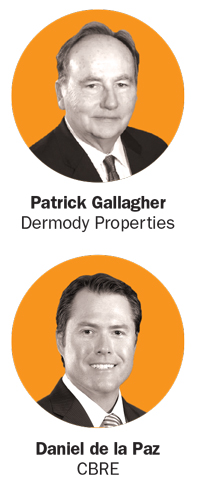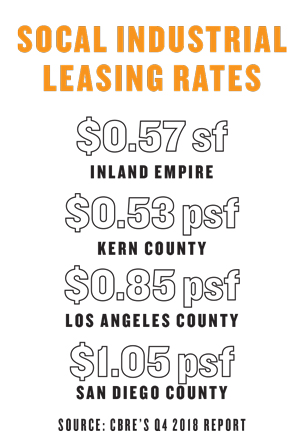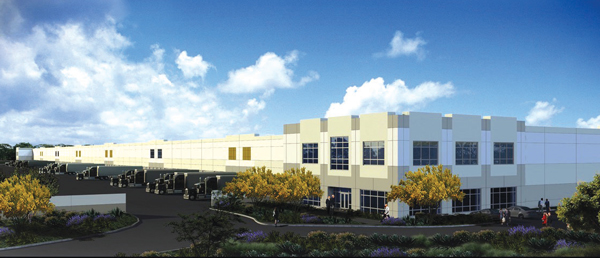This time last year, kids were gleefully hooting atop a roller coaster and other rides at the Scandia Family Fun Park in Ontario, California, which has been a mainstay of the Inland Empire landscape for 27 years.
But by early next year, the roller coaster, cliff jumper, arcade and miniature golf will be long gone, replaced by far less colorful industrial warehouses, reflecting a nationwide shift toward increasingly profitable logistics facilities.
In a deal that closed in February, the 12-acre Scandia Family Fun Park was acquired for $19 million by Bridge Development Partners, a national company that specializes in infill industrial properties. Greg Woolway, vice president of acquisitions for Bridge, said the location “was the heart of the Inland Empire.”
“It’s really ground zero for industrial real estate,” he said of the site, which will hold one 90,000-square-foot building and another building that’ll be about twice that size. Woolway said Bridge will break ground this summer in a bid to complete the project by the first quarter of 2020.

“Tenant and user demand justify speculative building at this point,” he said. “What has been brought to market has been leased or bought by end users, and there is still not a glut of good Class A product in the market.”
The former amusement park is, after all, in a region that has become the hottest commercial land worldwide. The Inland Empire ranks number one in the country for industrial real estate, owing largely to population density, proximity to ports and a healthy amount of construction of Class A facilities.
By the end of 2018, tenants in the region signed 20 of the top 100 industrial leases in the country, totaling 18.98 million square feet, according to the latest report from CBRE. That number was almost double the second busiest market, the I-78/I-81 corridor in Pennsylvania.
“The driver of the growth is really the ports,” said Daniel de la Paz, executive vice president of CBRE’s Ontario office, citing the San Pedro and Long Beach ports. “With the number of goods being imported, it makes a lot of sense for e-commerce corporations to be located here.”
As far as leasing goes, rates in the Inland Empire remain on par with other parts of the state and are significantly cheaper than those in San Diego County. The overall average asking lease rate for Inland Empire’s industrial property was $0.57 per square feet in the last quarter of 2018, according to CBRE. This compares with $0.53 in Kern County and $0.85 in Los Angeles County — though it’s about half the $1.05 per square foot demanded in San Diego County.
But local rates are on the rise — up 7.5 percent year-over-year in the fourth quarter of 2018, which de la Paz attributes to rising land values and construction costs. Rents are predicted to grow by 2.2 percent in 2019. But de la Paz added that moderate absorption rates will prevent any potential price gouging.
“It takes 6 to 12 months for absorption versus zero to 6 months at the peak of the last cycle,” de la Paz said. “I think the market is balanced with room to grow, thus it doesn’t appear that tenants are overpaying.”
 Buying industrial land in the area is particularly costly, said Patrick Gallagher, a partner for the Southwest Region at Dermody Properties, a Reno, Nevada-based company that specializes in the acquisition and development of industrial property.
Buying industrial land in the area is particularly costly, said Patrick Gallagher, a partner for the Southwest Region at Dermody Properties, a Reno, Nevada-based company that specializes in the acquisition and development of industrial property.
“If I’m buying land in the Inland Empire, which can range from $25 to $30 a square foot, I might be paying five or 10 times more than comparable land in Dallas,” Gallagher said. “But companies still choose to be here because of the logistics of where their merchandise is coming from and where it’s going. It’s location, location, location.”
Spec-tacular development
Given its large open tracts of land, the Inland Empire is ripe for industrial development similar to that of the Scandia property. Some 25 million square feet of new construction was completed in the Inland Empire region during 2018.
Dermody Properties recently acquired a 19-acre site in Rialto, which closed in late February. Construction on what will be known as the LogistiCenter building will be completed by the end of this year. The three-building complex is close to the I-210/I-15 interchange, and its logistics neighbors include Amazon, Monster Energy, Target and Under Armour.
Also in February, Dermody Properties began construction of a 262,260-square-foot distribution facility in Riverside, which is expected to be completed by the second quarter of 2019 under the LogistiCenter name. The company also acquired a 265,500-square-foot logistics building in an established industrial business park in Fontana. Aesthetic changes will be made to that site, as well as upgrades to its fire system. Between the development already underway and the acquisitions, all three Dermody Properties projects will have a combined estimated value of about $245 million.
The region is seeing a robust job market as well; last year, there were 162,600 employees in industrial distribution, up 7.4 percent over the previous year. All signs point to future growth, according to de la Paz of CBRE.
“Industrial bases are shrinking in other parts of Southern California,” he said. “If we look at Anaheim, Torrance or Long Beach, investors go in and buy industrial land [to] turn into apartments or mixed-use projects. So there will be expansion out to the Inland Empire.”
